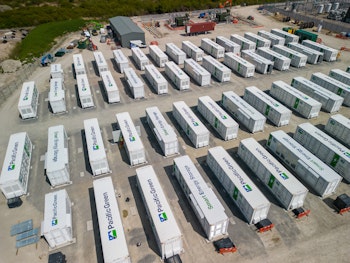
By Dane Wilkins
There is a reason a growing number of investors are keen to back battery energy storage projects. In many ways, they are great money-making machines. Like wind and solar projects, grid battery schemes score highly in terms of environmental, social and corporate governance value.
Like wind and solar, battery systems also represent a mature industrial technology class that is bankable and insurable. And like wind and solar, battery storage is an asset class that is only going to see growing demand as the trend towards decarbonisation of the energy system grows.
But there is one area where battery projects are markedly different from wind farms and solar parks. While the latter only have one way to make money - by generating clean electricity when the wind blows or the sun shines - batteries can tap into a range of revenue opportunities.
Money-Making Machines
The most obvious is price arbitrage, where a battery plant owner buys electricity when it is plentiful and cheap - and sells it back to the grid when supplies are scarce, and the price is high. Today, though, arbitrage is a minor source of income for many battery asset owners.
Instead, the big money is being made from providing ancillary grid services such as frequency response. These services are what keeps the grid’s frequency and voltage within the finely defined ranges required for system stability, and grid operators are happy to pay large amounts for them.
Finally, some countries - including the UK - operate capacity markets where the grid operator pays for assets to be on standby for likely peaks in demand, based on historical electricity consumption patterns. This is just a broad overview of options - in practice, a country may offer a wide range of markets that battery plant operators can tap into.
In the UK, for example, battery plant owners could potentially make money in wholesale, balancing, ancillary services, time-of- use, stabilisation and infrastructure markets. Each of these may have markets of their own.
The UK’s balancing market encompasses the spot trading, day-ahead, T-1 year-ahead and T-4 four-years-ahead markets, for example. These markets can change in line with emerging grid requirements and regulatory shifts.
Another UK example is the firm frequency response market, where capacity used to be procured every month. Starting in 2020, this was replaced by a trio of new capacity classes, starting with a service called dynamic containment.
The UK market is relatively advanced, however, and not everywhere benefits from so many potential revenue streams for energy storage. In Spain, for example, there is no capacity market - although plans are underway to launch one before 2025.
Nevertheless, a 2023 webinar by the Barcelona-based energy forecasting firm AleaSoft showed how even battery systems in Spain can benefit from a wide range of revenue options. AleaSoft unveiled how Spanish battery project revenues might change over time, with most income coming from ancillary services in the early years. Over time, however, electricity pricing arbitrage emerges as the biggest driver of revenues for projects.

Energy Arbitrage
This is to be expected: there is only a finite amount of ancillary services capacity needed to keep the grid in check. As energy storage deployments continue the ceiling will be met, meaning there is little ancillary services revenue left for new players.
The opportunities for energy arbitrage, however, are only likely to grow on the road to decarbonisation.
As part of the energy transition, almost all grid operators in developed economies are experiencing a gradual phaseout of large thermal plants, most notably those fired by coal or nuclear power.
In a net-zero world, the capacity provided by these plants will be replaced by wind and solar that is naturally intermittent in terms of production.
Hence, electricity production is increasingly at the mercy of the weather—and energy storage is needed to store excesses so they can be used when supply drops and demand rises.
This growing energy arbitrage opportunity is one reason why investors need not worry about current revenue streams dying out. Many of today’s revenue opportunities may indeed diminish in terms of importance but others, with arbitrage at the fore, will increase in size.
Another important feature of electricity market evolution is that the energy transition is placing greater stresses on the grid. Most grids were designed to take electricity from a few large generation sites to business and residential users over a wide area.
Now, the large generation sites are disappearing and instead electricity is coming from a growing number of distributed assets, such as wind farms and solar parks, which are oftentimes at the edge of the grid rather than in the centre.
Traditional grids were not built to manage this arrangement, with weaker grid-edge connections in danger of being overwhelmed.
Energy Asset Versatility
In the long term, grids will probably have to be re-designed with distributed renewables in mind—but for now, the simplest way to overcome grid constraints is simply to install battery systems wherever the network is strained.
These battery systems can then act as buffers against electricity network over-or under supply, removing the need for costly grid upgrades.
Nodal battery installations could benefit from local energy pricing arbitrage opportunities, particularly if grid operators and regulators introduce locational pricing to encourage electricity consumption at the point of generation.
Further reinforcing the case for energy storage is the way the grid is destined to integrate with transportation networks.
Vehicle electrification means a large part of electricity generation will go on moving cars, trucks and trains around, and these will all need readily available stores of energy for recharging. Few appreciate the scale of this transformation.
Already, for instance, truck companies are designing charging systems that have more than 100 times the capacity of standard electric vehicle chargers. A medium-sized transport depot could one day consume the entire electricity output of a small power plant.
None of this will happen without battery storage, however. And no matter what an energy storage system does to earn most of its keep, it will always have other options for making money.
No other energy asset offers this level of versatility—nor is there anything that is likely to come close to it in the future.
Publish date: 11 March, 2024